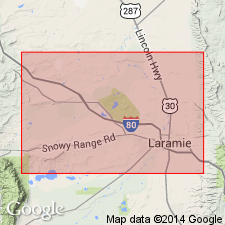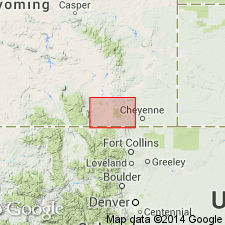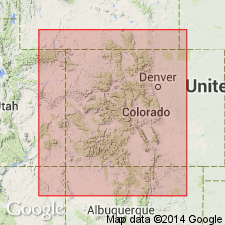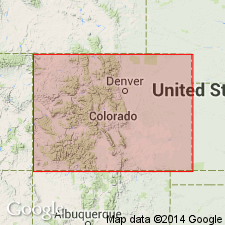
- Usage in publication:
-
- Sherman granite*
- Modifications:
-
- Named
- Dominant lithology:
-
- Granite
- AAPG geologic province:
-
- Southern Rocky Mountain region
Summary:
Name applied to large mass of unaltered, deeply weathered at surface, coarse, red granite in Laramie and Sherman quadrangles, WY in the Southern Rocky Mountain region. Intrudes hornblendic schists, schistose rhyolites, and gneisses, some of which metamorphosed volcanics. The contact of granite with the older rocks is nearly horizontal in many places. Unconformably overlain by Carboniferous rocks. Is of pre-Cambrian age; may be Algonkian.
Source: GNU records (USGS DDS-6; Denver GNULEX).

- Usage in publication:
-
- Sherman granite*
- Modifications:
-
- Overview
- AAPG geologic province:
-
- Southern Rocky Mountain region
Summary:
First publication to describe and show mapped extent of pre-Cambrian Sherman granite. As the youngest of the granites, Sherman is mapped in the Sherman Mountains, Sheep Mountain and Boulder Ridge in Laramie and Albany Cos, WY in the Southern Rocky Mountain region. Occurs as large body or batholith of very coarse grained, massive granite composed chiefly of pink feldspar, glassy quartz, and black hornblende and mica. A common phase is coarsely porphyritic with feldspar crystals 1 to 2 inches long. Disintegrates readily where exposed. Fine-grained and locally porphyritic granites that occur as stocks, sills, and dikes also mapped as Sherman because they are thought to be part of the same magma and same intrusive episode. The granite on Sheep Mountain is finer grained. The colors of the feldspars may also be white, gray to deep red. Intrudes gneiss and schist; the contact is sharp at many localities; the contact is a broad breccia zone at other localities--Deer Creek for example. The next younger unit in the area is the Casper formation. Columnar sections.
Source: GNU records (USGS DDS-6; Denver GNULEX).

- Usage in publication:
-
- Sherman Granite*
- Modifications:
-
- Overview
- AAPG geologic province:
-
- Southern Rocky Mountain region
Summary:
Occurs in a batholith that straddles CO-WY boundary. Listed with granitic rocks and gabbro of circa 1,400 m.y. (Precambrian Y) age group.
Source: GNU records (USGS DDS-6; Denver GNULEX).

- Usage in publication:
-
- Sherman Granite*
- Modifications:
-
- Overview
- AAPG geologic province:
-
- Southern Rocky Mountain region
Summary:
A large batholith and related plutons in northern Front Range (Southern Rocky Mountain region) that lie principally in Medicine Bow Mountains, WY, but extend a short distance in Front Range, CO. Southern part of batholith is a circular ringdike structure. Outside the structure, Sherman is a red, coarse-grained equigranular. Inside the structure, Sherman is a pinkish-gray, porphyritic biotite quartz monzonite that shows flow layering. Has a Rb-Sr isochron age of 1,430 +/-20 m.y. and a U-Pb age of 1,422 +/-15 m.y. Cut by Silver Plume Granite, for which an age of 1,392 +/-30 m.y. reported. Is one of ten named units assigned to Middle Proterozoic Berthoud Plutonic Suite, defined in this report.
Source: GNU records (USGS DDS-6; Denver GNULEX).
For more information, please contact Nancy Stamm, Geologic Names Committee Secretary.
Asterisk (*) indicates published by U.S. Geological Survey authors.
"No current usage" (†) implies that a name has been abandoned or has fallen into disuse. Former usage and, if known, replacement name given in parentheses ( ).
Slash (/) indicates name conflicts with nomenclatural guidelines (CSN, 1933; ACSN, 1961, 1970; NACSN, 1983, 2005, 2021). May be explained within brackets ([ ]).

